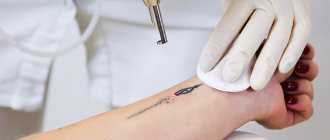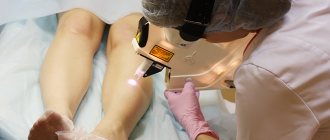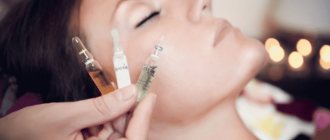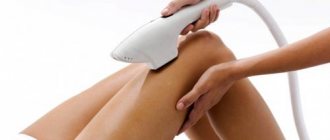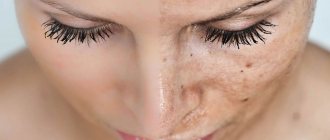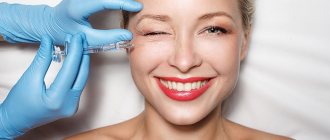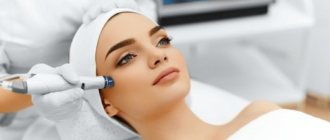Facial skin care after mesotherapy
It is important to understand that mesotherapy, although it is a cosmetic procedure, is a medical intervention in the body. And this implies strict adherence to the set of post-injection measures prescribed by the doctor. Only in this case the result will be long-lasting and without any complications.
Any injection, even made with ultra-thin needles to a shallow depth, is in its own way a microtrauma of the skin. This means that they need some time to fully heal, which, in turn, requires careful care of the treated area.
Depending on the composition of the injection (and it may vary in each specific case), the process of absorption of the active substances may take several days. Violation of the doctor's recommendations can easily lead to negative side effects, as well as a decrease in the effectiveness of therapy.
How does the mesotherapy procedure work?
Injections of mesopreparations: photo
As we said above, injections of mesopreparations are made using a syringe and very thin needles 30, 31 or 32G (needle diameter 32G = only 0.23 mm). In mesotherapy, there are 4 main injection techniques - nappage, papules, tubercles, and linear-retrograde technique. Anesthesia will be required before the procedure begins. Pain relief during mesotherapy of the face and neck is carried out using a cream or gel based on the anesthetic lidocaine (in concentrations from 5 to 12%). The cream is applied to the face under the film for 20 minutes.
Above, we already told you about lymphatic drainage vascular injection of the face and neck (capillary mesotherapy), which is necessary to activate lymphatic drainage and blood supply to the skin. This is necessary both for patients with finely wrinkled type of skin aging, and especially for deformational/edematous type of aging. But if with the finely wrinkled type the vascular injection is done only in the first 1-3-5 procedures (we look at the condition of the skin and age), then with the deformation type the vascular injection should be done in each of the 10-12 procedures.
Lymphatic drainage vascular puncture technique –
During mesotherapy of the face and neck, a vascular puncture will activate the regional lymph nodes of this area, improve lymphatic drainage, relieve swelling of the dermis and subcutaneous fat, strengthen the walls of blood vessels, and also reduce the volume of fat bags on the face and neck. For example, your wrinkles, jowls or double chin will also be reduced. For vascular/lymphatic drainage injection, drugs such as “GAG Complex DVL Capyl formula”, “Gingko Biloba”, “Artichoke”, “Rutin + melito extract” are used.
Small injections are made into certain areas: the entire cervical-collar area (to the level of the shoulder blades), on the face and neck - in the projection of all groups of lymph nodes. If there is a large volume of fat on the face and neck, we can also pierce the middle/lower third of the face along the massage lines + the entire second chin. The volume of vascular preparations for 1 procedure is 5 ml. And only after this (in the second part of each procedure) we do injections of mesopreparations aimed at rejuvenation.
Another option is not to use age-correction drugs at all during the first 2-3 procedures, but to combine vascular lymphatic drainage injection on the face and cervical-collar area with the use of soft lipolytics. Lipolytic injections are made in the area of excess fat, such as lip bags, nasolabial folds, jowls and double chin. And starting from the 3-4th procedure, we begin to combine vascular drugs with mesopreparations intended for age correction.
Mesotherapy injection techniques –
There are only a few of these techniques, and below you can read not only their descriptions, but also see videos demonstrating them. Please note that injection techniques in mesotherapy and biorevitalization are completely the same, so do not be embarrassed if the term biorevitalization sometimes appears in the videos below. The process of injecting the mesopreparation usually takes no more than 15-20 minutes (not including time for lymphatic drainage vascular injection, anesthesia, and a regenerating mask after the procedure).
1) “Nappage” technique (superficial, middle, deep) – with superficial nappage, the tip of the needle does not penetrate the dermis, i.e. the doctor works only at the depth of the epidermis, which will mean the absence of blood discharge from the needle insertion points. This technique is characterized by too much consumption of the drug, which must dry on its own. In theory, this should help the active substances penetrate the dermis, but in fact this is the most ineffective of mesotherapy techniques.
The median nappage technique is much more effective, and in this case microdoses of the drug will enter the upper layers of the dermis to a depth of 1-1.5 mm (hence, there will definitely be blood dew from the injection sites). With each needle insertion, only 1 drop of the drug is released, which usually does not cause the formation of papules, or they quickly disappear. But the deep nappage technique is used in patients with thick skin and is distinguished by the fact that the needle is inserted already at 2-3 mm.
Nappage: superficial (video 1) and middle (video 2)
2) “Papules” technique (superficial or middle) - this technique involves injections into the upper or middle layers of the dermis, so that at the site of each injection a “papule” will appear, which looks like an elevation above the surface of the skin. The size of the papules will depend on the volume of mesopreparation injected into the tissue at each needle insertion point. Papules can be small (about 1-2 mm) - in this case they are called micropapules. The volume of the drug at each point will be about 0.01-0.02 ml, and the distance between them will be from 0.3 to 0.5 cm. Such papules are made in areas with thin skin, for example, in the periorbital zone.
In areas with denser skin, papules are made to a standard size, i.e. with a diameter of 3-4 mm. The volume of the drug at each point will be about 0.03-0.04 ml, and the distance between injections will be about 1.0-1.5 cm. Keep in mind that the larger the papules, the slower they will dissolve. Usually papules disappear within 2-3 days, less often - up to 5-7 days. Sometimes papules can take up to 2-3 weeks to resolve, but this is usually due to a doctor’s mistake (when a cosmetologist administered a drug based on stabilized HA in the form of standard papules, which cannot be done).
Papule technique: video
3) “Tubercles” technique – if the previous technique involves introducing mesopreparations at an angle of 15 degrees to the surface of the skin (into the superficial and middle layers of the dermis), then in this case the drug is injected with a 32G needle at an angle of 45 degrees to the entire depth of the needle. In this case, the drug depot is created in the deep layers of the dermis, at a depth of approximately 3 mm. This technique is distinguished by the absence of elevations on the surface of the skin in the form of papules, and after the procedure only traces of needle injections will be visible. However, this technique has a greater risk of hematomas.
4) Linear-retrograde technique - technically this technique is the most complex, and it came to mesotherapy from contour plastic surgery. If for all previous techniques 4 mm needles are most often used, here they are 12-13 mm long. After injection, the needle moves into the dermis parallel to the surface of the skin over its entire length. The drug is eliminated when the needle moves backwards in a retrograde manner. This is the most effective mesotherapy technique, although it is more traumatic. But the fact is that in this case, additional trauma to the dermis is a plus - the body responds to it with regeneration and an increase in collagen synthesis.
Linear-retrograde technique: video
General recommendations after facial mesotherapy
The rules for skin care after injections are simple and do not require significant costs. Widespread Chlorhexidine will need to be applied to the treated area daily (once a day). To protect against external irritants (primarily direct sunlight), use sunscreen with a high protection index. Finally, medicinal gels (such as Bepanten, or the well-known Panthenol) are used to speed up healing. If there are visual defects caused by injections (hematomas or bruises), it is recommended to use regular Troxevasin ointment.
At the same time, we must not forget about the presence of possible contraindications, so a preliminary consultation with a specialist (especially if you have allergies) would be a reasonable option.
Efficiency
When carrying out the procedure, the result can be assessed after the first session. But to obtain a lasting and pronounced effect, you will need to take a course, the duration of which, as well as the frequency of procedures, is selected separately by a cosmetologist for each patient.
Most often, it is recommended to undergo 10-12 facial mesotherapy procedures with an interval of 7-10 days.
Thanks to facial mesotherapy it is possible to:
- reduce the severity of age-related changes, in particular reduce the depth of wrinkles and folds;
- reduce the volume of soft tissues and eliminate swelling, including tightening the chin and removing the double chin, which provides the so-called non-surgical modeling effect;
- improve the shape of the face by eliminating signs of gravitational ptosis;
- reduce the number and severity of inflammatory elements on the face, including acne;
- reduce or completely remove pigment spots and skin redness;
- improve skin texture, in particular smooth out scars and post-acne marks;
- remove bags and dark circles under the eyes, eliminate sagging eyelids, crow's feet;
- improve the appearance of the lips by smoothing purse-string wrinkles, eliminating dry lips, making their contour clearer;
- give your facial skin a fresh, rested look and ensure its effective hydration;
- restore the thickness of the eyebrows and fill in the “gaps”.
But the effect of facial mesotherapy largely depends on the correct selection of the features of the procedure in accordance with the type of skin aging (finely wrinkled, deformed, tired, mixed). When all factors are taken into account, the correct selection of medications is taken and the full course of procedures is completed, the achieved effect can last up to 1.5 years. And to extend this period, it is recommended to regularly perform maintenance procedures.
In Russia, the most common types of aging are deformational or edematous and finely wrinkled.
What not to do after facial mesotherapy
The main restrictions after the mesotherapy procedure concern the first and second days. During this period, it is strongly recommended:
- avoid water treatments;
- show increased physical activity - during the rehabilitation period you will have to forget about gyms and fitness clubs;
- ensure skin protection from thermal effects - visiting saunas and baths, as well as direct sunlight, regardless of their intensity;
- refrain from using cosmetics (even those with natural ingredients); This restriction does not apply to medical products.
To summarize, let's say the following: each procedure (cosmetological or medical) is truly effective only if the recommendations prescribed by the doctor are followed. If you ignore these simple rules, at best the effect will be neutralized, and at worst, side effects and complications will arise.
| Author of the article: | Deusheva (Nesterenko) Oksana Leonidovna |
| Speciality: | Cosmetologist, dermatovenerologist |
| Experience: | 8 years |
Make an appointment
Indications for use
The procedure has an extensive list of indications. But only a qualified cosmetologist can determine whether a particular patient requires facial mesotherapy. In general, it is indicated for:
- signs of biological aging of facial skin (wrinkles, ptosis) to reduce the depth of wrinkles, increase skin tone, improve its color and texture;
- photoaging to moisturize the skin and eliminate hyperpigmentation;
- local obesity, in particular the formation of a double chin or fatty bags on the face;
- acne;
- scars, scars, post-acne;
- bags and circles under the eyes;
- spider veins, rosacea, rosacea;
- enlarged pores;
- preparation for chemical facial peels, plastic surgeries and during the recovery period after them.
You can perform facial mesotherapy from the age of 18, but it works best after 25 years and on aging skin that has not previously undergone complex care.
The procedure can also act as an effective means of preventing age-related changes.
Contraindications to mesotherapy
The procedure is not carried out if:
- oncological diseases;
- inflammatory processes, abrasions, wounds in the area of work;
- blood clotting disorders;
- pregnancy;
- breastfeeding;
- hemophilia, diabetes mellitus;
- a large number of moles, papillomas in the injection area;
- taking anticoagulants or other drugs that affect blood clotting;
- acute period or exacerbation of infectious and other diseases.
The procedure is not recommended during menstruation. Ignoring these contraindications may cause negative effects after the procedure.
Advantages and disadvantages
Injections with meso-cocktails penetrate well into the layers of the dermis and act safely and quickly. Among the advantages:
- non-traumatic - specialists use the finest needles to administer drugs, the use of which is accompanied by minimal discomfort;
- no pain – needle-free methods eliminate pain, non-invasive techniques are suitable for people with a high sensitivity threshold;
- non-concentrated formulations – the concentration of components in one dose allows the active composition to be evenly distributed;
- safety – mesotherapy cocktails consist of ingredients that do not cause allergic reactions or side effects;
- have no age restrictions;
- The result after completing the course can last up to 5 years.
Despite the impressive list of advantages, there are also negative aspects that a good specialist will definitely tell you about during the consultation:
- discomfort upon contact with the needle, as well as after the end of the anesthesia;
- swelling at the puncture site (papules), minor hematomas that go away on their own within 2-3 days after visiting a cosmetologist;
- the need to take a full course, its high cost.
In general, we can say that mesotherapy is an effective cosmetology method with many advantages.
Biorevitalization prices
| Service code | Area of influence / List of procedures / Drug | Price |
| А11.01.012 | JALUPRO | 7000 |
| A11.01.013 | VISCODERM 0.8% | 8500 |
| A11.01.013 | VISCODERM 2.0% | 9500 |
| А11.01.012 | AQUASHINE | 15000 |
| A11.01.013 | MESO-WHARTON P199 | 18500 |
*
— the price is indicated in rubles
